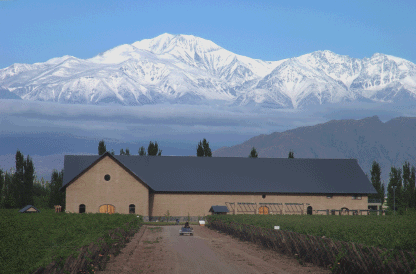Dr Vino's wine blog
wine talk that goes down easy
Argentina: falling peso, rising quality

Argentina has been in the headlines recently for its currency devaluation and defaulting on its international loans. But what hasn’t been in the general news is the quality of the wines. Given that the country is now “on sale,†are we likely to see discounted prices here in the US? Sadly, the answer is probably not. But at least we have good quality to console us.
Endowed with an excellent growing climate for wine, an association for Argentine growers claims they are on “the right side of the Andes†(a not-so-subtle jab at their neighbor and rival, Chile). The Mendoza province, where most of the wine growing occurs, lies on the flanks of the Andes where vistas of rows of vines evaporate into snow-capped peaks. The high desert has growing areas between 2,500 and 4,000 feet that provide for hot summer days and cool nights, a perfect climate for wine grapes.
But sadly the natural potential of Argentina went largely untapped for too long. Argentina has always been a prolific producer of wine with harvests that make the country one of the largest producers in the world (it is currently fifth behind France, Italy, Spain and the US). Indeed, quantity—not quality—was the prevailing orientation of the winemakers throughout the 1970s and into the 1980s. Yields were kept high as grape prices were set simply by harvest weight without quality considerations.
It is not surprising, therefore, that most of this production remained on the domestic market. What is surprising, is that people drank it! As recently as the 1970s, Argentines drank an astonishing 90 liters per person. Exports accounted for very little of the production and Argentine wines were largely unknown overseas.
Declining consumption rates, however, snapped the producers to attention. With the rising popularity of beer and soft drinks, wine consumption declined dramatically (today it is 39 liters per person, about the same as France and Spain and four times that of the US). Suddenly, the producers found surplus wine driving down prices. Many went out of business and vineyard area declined by about one-third during the 1980s.
Quality production emerged as a strategy to combat the trend of falling prices. However, in the mid-1980s, the time was not right as hyperinflation plagued the Argentine economy. Inflation of 2,500% a year prevented producers from purchasing the necessary equipment to stage a transition to quality. As the currency sagged noticeably from day-to-day things such as new oak barrels that producers had to import became increasingly expensive.
In an effort to slay the beast of hyperinflation, the Menem government took the bold step in 1991 of pegging the peso to the dollar. This achieved the price stability that the economy had been lacking (but would prove disastrous ten years later). Price stability had two key impacts on Argentine wine production: quality winemaking equipment from abroad became more affordable and Argentina became more attractive to foreign investors.
For wine regions to grow qualitatively, it is helpful to have a leader who achieves a major breakthrough. In French, such a leader is known as a “locomotive†pulling the region along behind. One of Argentina’s locomotives is Nicolas Catena. An economist by training, he gambled that the dollar peg would bring economic stability and invested in quality. His wines received favorable reviews and attracted international attention.
Foreign capital started to flow in. Now, the Argentine wine industry has possibly the most international group of firms participating in any wine growing area. Wine producing firms from Bordeaux and Champagne, the US and even Chile have bought up assets. Since most of the recent trend occurred before the recent devaluation, it is not attracting simply the value players. Just this week, the owners of Chateau Cheval Blanc, one of the highest-regarded Bordeaux producers announced that they will be making a red wine from Argentina and calling it “little Cheval-Blanc†with a price tag of $80.
The crucial questions for American consumers now are: will the current crisis decrease the quality of the wines? And are we likely to see better values emerge?
Quality will likely continue on its upward trajectory. The excellent growing environment has not been affected by the political and economic instability. Further, for foreign investors, the country now is selling at a discount as the good land is cheap. In fact, the low prices may soon be gone as the peso appears to have bounced off the bottom (the Argentine stock market is up 22% this year in dollar terms). Domestically capitalized wineries, however, have seen their costs triple on imported items needed for quality production.
Wine prices, unfortunately, are not likely to decline in the US. Given that the major obstacle for Argentine wines is a lack of recognition, a good stint of high quality at low prices would benefit the entire industry (not to mention that strong exports would help the economy). However, the good producers already have solid foreign demand for their product thanks to favorable reviews. And a recent rise of wine bars in Buenos Aires has made more demand for quality wines at home. But all participants in the industry, in Argentina and the US, would be well-advised not to let this economic window of opportunity close before the consumer has had a chance to benefit.
While there is now good quality available, it remains patchy from producer to producer and stuck at a frustratingly high price point. Several bargain wines are available for under $10, but it may be a few more years before quality is consistently good across the whole range of production. The dynamism and potential definitely make Argentina a country to watch.



